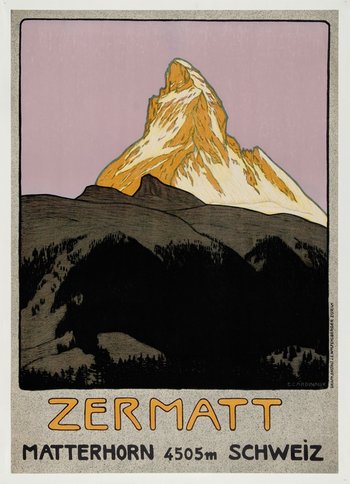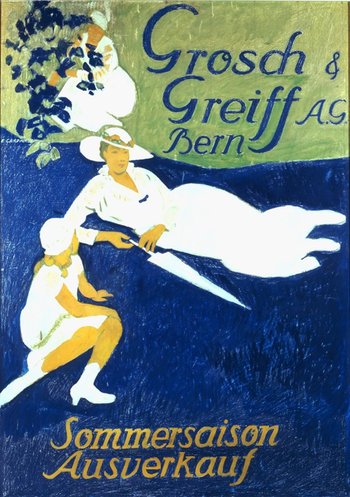Emil Cardinaux, pioneer of Swiss poster art

In 1908, the Swiss mountain village of Zermatt published a poster featuring its most famous landmark: the towering Matterhorn peak. This image heralded the dawn of modern Swiss poster design.
Swiss tourism started booming at the end of the 19th century with increasing accessibility of remote Alpine regions. Zermatt owed much of its popularity to the Matterhorn, which had first been climbed in 1865 by a team of British mountaineers and Swiss mountain guides. It was the early days of travel advertising in Switzerland, and most posters featured detailed, realistic images of landscapes, sometimes populated with elegant tourists or locals in traditional dress, and often included a train schedule.

The 1908 Zermatt poster was designed by an up-and-coming young artist named Emil Cardinaux and offered a new and unique artistic take on this Swiss icon. The whole lower half of the image is occupied by the dark grey mass of a mountainside cast deep in shadow. Above it rises the rocky, pyramidal peak whose snow-covered flanks reflect the glow of the setting sun, while the sky is rendered in a surprisingly antinaturalistic purplish pastel colour. The overall effect recalls the magical colours of Alpenglow, a phenomenon that occurs right before sunrise or right after sunset. The bold outlines and large flat blocks of colour are inspired by Japanese woodblock printing, which had a strong influence on Western artists in the late 19th century. A similar style can be found in other early 1900s travel posters, but its use to create a monumental depiction of a landscape feature is new in Cardinaux’s design.
Emil Cardinaux was born in Berne in 1877. He loved drawing from early childhood and used to draw caricatures of his schoolmates and teachers. As a teenager, Cardinaux founded a mountaineering club with his friends and kept diaries of his Alpine tours which he illustrated in detail. After starting to study law at the University of Berne, Emil Cardinaux moved to Munich in 1898 to continue his studies there. He soon broke off his law course in order to focus on his real calling: art. He studied under Franz von Stuck, a co-founder of the Munich Secession, and in the next few years took trips to the Netherlands, Paris and Italy. Back home in Berne from around 1905, Cardinaux started taking commissions as a painter and graphic designer.
In 1908, the Swiss mountain village of Zermatt published a poster featuring its most famous landmark

Emil Cardinaux was within the circle of artists influenced by Ferdinand Hodler and made a name for himself as one of the most progressive Swiss painters of the early 20th century. More than as a painter, Cardinaux was particularly successful as a graphic designer, putting his artistic skill in the service of high-quality advertising. He had learned lithography during his time in Munich and understood perfectly how to use the technique to produce highly effective, artistic advertising images at the lowest possible cost.
Cardinaux designed more than 130 posters and a variety of smaller printed advertising materials in the realms of fashion, consumer products, cultural events, charities, hotels, transport companies, travel destinations and, later on, political causes. Within Cardinaux’s many-faceted oeuvre, we find sophisticated elegance in designs for the famous St. Moritz Palace Hotel (1920) or the Grosch & Greiff clothing store in Berne (1915), a touch of humour in posters such as the one for Villars chocolate (1905), and the majesty of Switzerland’s landscapes in his travel posters. His landscapes are especially striking, as they reflect Cardinaux’s own love for the mountains and his talent for capturing the beauty of his natural surroundings. While his designs were largely praised by his contemporaries, Cardinaux did manage to cause a famous scandal with his poster for the 1914 Swiss National Exhibition whose “green horse” was met with near-universal outrage.
The posters from later in Cardinaux’s career, after the First World War, present a more idealised image of Switzerland, increasingly dominated by figures representing a down-to-earth Swiss stereotype. During this time, a new generation of poster artists were taking over the lead, but Cardinaux had made his mark. Alongside his contemporaries Augusto Giacometti, Otto Morach, Carl Moos, Burkhard Mangold, Walther Koch and Otto Baumberger, Cardinaux had helped lay the groundwork for a productive and innovative Swiss poster art scene. His work had drawn international attention to Swiss graphic design, which was to reach the peak of its fame with the development of the Swiss Style later in the 20th century. Today, Cardinaux’s works are highly sought after on the vintage poster market. Many were lithographed on stone at the Wolfensberger printing company in Zurich, and even a century later, the colours remain as fresh and luminous as though they were printed yesterday.
See more about author's (Artifiche) member page
References:
C. A. Loosli: Emil Cardinaux. Eine Künstlermonographie, Zurich 1928.
Museum für Gestaltung Zürich (ed.): Emil Cardinaux, Reihe Schweizer Plakatgestalter 2, Zurich 1985.
Bettina Richter and Andrea Eschbach: Plakat, Zermatt, 1908, Emil Cardinaux, Museum für Gestaltung Zürich eGuide.
Thomas Bolt: Cardinaux, Emil, in: SIKART Lexicon on Art in Switzerland, 1998/2012
Images related to the article
[Fig. 1] Emil Cardinaux’s 1908 poster for Zermatt featuring the famous Matterhorn peak is widely considered to be the first modern Swiss poster. Zermatt – Matterhorn, Emil Cardinaux 1908
[Fig. 2] A rare bit of humour: Cardinaux’s 1905 advertisement for the Villars chocolate company alludes to the famous fable about the fox and the crow. Chocolat de Villars, Emil Cardinaux 1905.
[Fig. 4] When this poster for the 1914 Swiss National Exhibition was exhibited, it caused a scandal because of the horse’s greenish colouring. Swiss National Exhibition Berne, Emil Cardinaux 1914.
[Fig. 5] This extraordinary gouache draft for Cardinaux’s 1915 poster advertising the summer sale at a fashion store in Berne evokes cool summer elegance. Grosch & Greiff AG Bern, Emil Cardinaux 1915.
[Fig. 8] This 1917 design for St. Moritz provides an unexpected view of the beautiful Engadine landscape while also depicting two different winter activities that the resort’s fashionable clientele enjoyed. St. Moritz, Emil Cardinaux 1917.
[Fig. 9] These elegant Palace Hotel guests at the ice skating rink epitomise high-class winter holidays in St. Moritz. Palace Hotel St. Moritz, Emil Cardinaux 1920
[Fig. 10] Cardinaux designed this poster in 1920 for the campaign urging Swiss voters to say “yes” in the referendum on joining the new League of Nations. Ja zum Völkerbund, Emil Cardinaux 1920.










